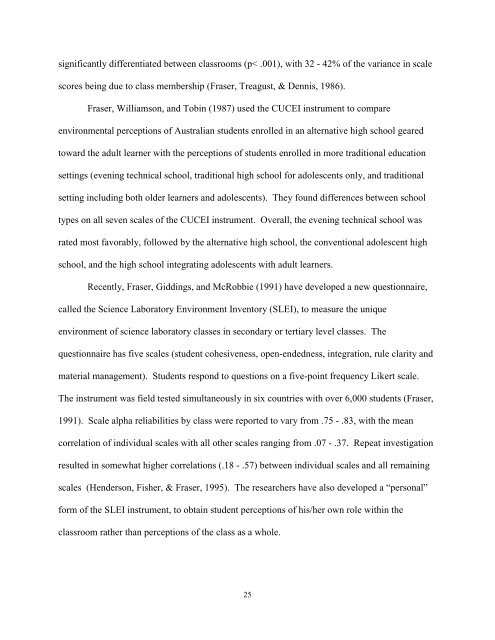STUDENT EVALUATION OF CLINICAL EDUCATION ENVIRONMENT
STUDENT EVALUATION OF CLINICAL EDUCATION ENVIRONMENT
STUDENT EVALUATION OF CLINICAL EDUCATION ENVIRONMENT
You also want an ePaper? Increase the reach of your titles
YUMPU automatically turns print PDFs into web optimized ePapers that Google loves.
significantly differentiated between classrooms (p< .001), with 32 - 42% of the variance in scale<br />
scores being due to class membership (Fraser, Treagust, & Dennis, 1986).<br />
Fraser, Williamson, and Tobin (1987) used the CUCEI instrument to compare<br />
environmental perceptions of Australian students enrolled in an alternative high school geared<br />
toward the adult learner with the perceptions of students enrolled in more traditional education<br />
settings (evening technical school, traditional high school for adolescents only, and traditional<br />
setting including both older learners and adolescents). They found differences between school<br />
types on all seven scales of the CUCEI instrument. Overall, the evening technical school was<br />
rated most favorably, followed by the alternative high school, the conventional adolescent high<br />
school, and the high school integrating adolescents with adult learners.<br />
Recently, Fraser, Giddings, and McRobbie (1991) have developed a new questionnaire,<br />
called the Science Laboratory Environment Inventory (SLEI), to measure the unique<br />
environment of science laboratory classes in secondary or tertiary level classes. The<br />
questionnaire has five scales (student cohesiveness, open-endedness, integration, rule clarity and<br />
material management). Students respond to questions on a five-point frequency Likert scale.<br />
The instrument was field tested simultaneously in six countries with over 6,000 students (Fraser,<br />
1991). Scale alpha reliabilities by class were reported to vary from .75 - .83, with the mean<br />
correlation of individual scales with all other scales ranging from .07 - .37. Repeat investigation<br />
resulted in somewhat higher correlations (.18 - .57) between individual scales and all remaining<br />
scales (Henderson, Fisher, & Fraser, 1995). The researchers have also developed a “personal”<br />
form of the SLEI instrument, to obtain student perceptions of his/her own role within the<br />
classroom rather than perceptions of the class as a whole.<br />
25












